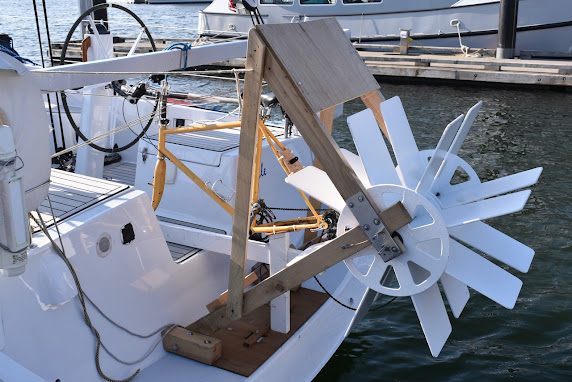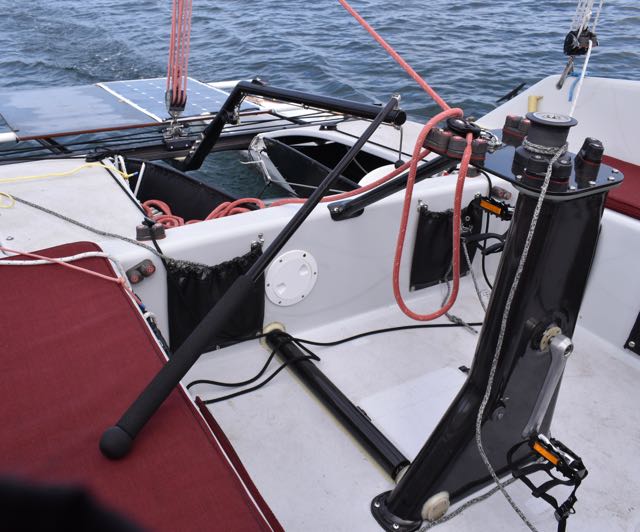Here are photos of some pedal drive units that caught my eye in the 2018 R2AK.
This post is a bit short on the technical side because there wasn't time for those kind of questions, but I'll update the post if anyone wants to contribute.
Every competitor's pedal drive system got worked hard this year because there just wasn't much wind, so it was a good year to learn about them.
My pedal drive system worked beautifully in the R2AK, thanks to lots of design help and a good machinist (see previous post) There were much simpler systems on other boats that seemed to work fine too.
The system below was my favorite, not because of the basket and flowers, but because it was so simple and it worked.
The gearing was timed so that each pedal stroke would equal one propeller blade entering and exiting the water.
The surface-piercing propeller has been used for pushing big boats with human power before (on "Bad Kitty" last year, for example) and the lack of complexity is appealing.
This system was on "Take me to the Poolroom", which finished fifth.

Another extremely simple system was this on an F-28. When I saw this I was doubtful that it would hold up. It did. In fact both of them did (one on each side) and the crew said that they worked well.
The exposed chain would cause drag for sure, but a fairing could be used. The boat also had rowing stations.

The Nacra Inter 20 had twin pedal drive stations rotating forward (to kick up) on the same cross bar.
I don't know about the innards, but it looks like gears and a drive shaft.
This boat was doing well the first day, but didn't continue.

Sail like a Girl had store bought units with seats attached. These were Wave Walker units that use a twisted chain (I believe) and I was impressed that these units were still working at the finish because pushing a pedal powered kayak is quite different from pushing a big sailboat long distance.
The delivery crew for the return trip said that they were not working a week or so after the race.
This boat had four people prying her through the water whenever the speed dropped below 4 knots, two on the pedals and two on stand-up paddles.
Sail like a Girl won this year's R2AK out of determination and a lot of pedaling and paddling.

This system on Wild Card seemed like it pushed the boat really well. There was only one unit and no rowing stations and they finished third. I never found out what is inside the leg, but my guess is right-angle gears and a drive shaft.

My drive unit from last year was on the Olson 30 Dreamcatcher. It got modified a lot at the upper end to allow facing aft instead of facing sideways and it was still going strong at the end of the race.

My 2018 drive system may have been the most complicated, but it deployed and retracted easily, it was quiet, and it was easy to use with the sails assisting. My speed without any wind was 2 1/2 to 3 knots, but I could motor sail up to about 5 knots.
I started with a 16" diameter x 16 pitch propeller, but bought a giant 20" x 18 pitch and cut the tips off to make it about 17" diameter. That prop was to be used just for motor sailing, but it stayed on the whole way. Rpm's at the cranks were about 65 at cruising speed.
The leg never leaked a drop (through the prop shaft or anywhere else), so the belt and aluminum pulleys stayed dry.
My knees got totally hammered from pedaling. Why? Was it the uneven cranking revolutions inherent in most of these systems (cranks and propeller slowing between pedal strokes)?

I'm pretty sure that the most efficient drive system was on this boat, Mat Johnson's "Take me to the Volcano".
Matt is facing backwards in this photo. Just behind him are the cranks, pedals and bicycle style gearing and a short shaft that runs to a 90 degree gearbox at the hull side. The gearbox is angled downward to force the long spring stainless propeller shaft (visible in the photo) down into the water.
The thin aluminum strut at the propeller rotates sideways to lift the prop and shaft clear of the water.
This system was designed by Rick Willoughby. Here's an example of the kind of power a system like this can generate:
https://www.youtube.com/watch?v=0JH5wx-4OoI

What will we see next year? Will someone develop a production leg (lower unit) that can be adapted to different boats? Will surface piercing propellers become more widely used? What about flywheels to even out the rpm's?
Pedal drives can mess with your head. Every system is a combination of compromise and complexity, but there are worse things, I guess.
This photo courtesy Katrina Zoe Norbom



















































